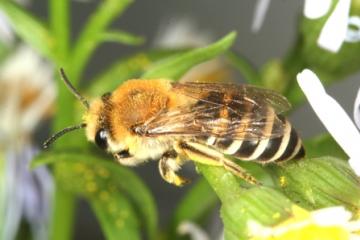Species Account for Colletes halophilus
Colletes halophilus Verhoeff, 1943
a mining bee
Aculeata: Colletinae

Reproduction for study and non-profit use permitted, all other rights reserved.
Taxonomic group: bees and wasps (Aculeata) - County data
View time series maps for Colletes halophilus
member log-on for taxon report
Status: Na;Section 41 Priority Species
Essex RDB: Listed
Threat: Regionally Important
Images
upload a new image
Essex Red Data List comment
forages on Sea aster
Species text
This mining bee is an endemic species of the southern part of the North Sea coasts, where the species is confined to the coasts of eastern and southern England, south-west Germany, the Netherlands, Belgium and north-west France. In Britain most records are from the south-east and East Anglia. Britain holds internationally important populations of C. halophilus (Harvey 2001) with the most important ones occurring in the Thames estuary and Essex coast (see maps).
Females have a close association with flowers of Sea Aster Aster tripolium, from which they collect pollen to provision their nest cells, and the species has a late season coinciding with the flowering of its forage plant. It nests, often in large aggregations, on bare sandy soil and south-facing sunny slopes in upper saltmarsh or situations close by. However the localities that support the largest populations are often where human intervention has extended the upper saltmarsh habitat into more extensive areas on artificially produced substrates such as silt and pulverized fly ash (PFA) lagoons.
Falk (1991b) states that the bee has probably been lost from many sites through coastal development and the loss of upper saltmarsh in recent decades. The species is threatened in various ways. The grazing of upper saltmarsh produces grass swards that contain little suitable forage. Rising sea levels are causing erosion of salt marshes in Essex and at the present rate most of the habitat will have been lost within a few decades (Gibson 2000). Managed realignment should benefit this species at some places on the Essex coast. However many of the Thames Marshes have been reclaimed for industrial development, and with the abandonment of older industrial sites next to the Thames, there is now enormous pressure from initiatives such as the 'Thames Gateway' to redevelop, often for high value riverside housing. Barking riverside and PFA lagoons and various sites on the Kent side of the Thames have been lost in recent years. Virtually all the remaining East Thames Corridor localities are under imminent threat of destruction or severe degradation. References
Habitats
Recorded management for locations with Colletes halophilus
Recorded substrate and hydrology for locations with Colletes halophilus
Why not join the Club, register and add a new species page
Interpretation of distribution maps






















